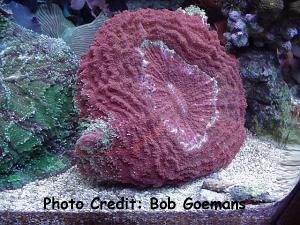
By Bob Goemans

Likely Reef Tank Suitable
Likely Fish-Only Tank Suitable
Range: Indo-West Pacific Ocean: Red Sea to the Great Barrier Reef.
Natural Environment: This mostly circular in shape photosynthetic stony coral with a single large fleshy polyp generally inhabits protected reef environments, where it’s sometimes found attached to walls under overhangs, yet usually found free-living on sandy or muddy bottoms where gentle currents exist. Its tentacles are usually only displayed at night when they feed on available plankton. Often found in various color combinations, including highly fluorescent colors, e.g., red, orange, pink, and greens.
General Husbandry: This is a beautiful and very hardy coral and is seen infrequently in the trade. Except for proper placement in the aquarium, it requires little intervention from the aquarist to remain healthy.
As for placement, either place on bottom substrate where disturbed sand would not cover its large polyp, as this may cause it to become stressed when sloughing off excessive sand particles. It may also be placed about half way up in the aquarium in a shady and secure area where the weight of its very large single polyp will not excessively overlap the area its skeleton is setting on, as the weight of the overlapping tissue may tear the polyp, especially if it receives more than gentle water movement. Moderate light is also an important aspect, as this coral does not like direct bright light. Very gentle water currents are required, not only to prevent the large polyp from withdrawing in size, but for carrying food to it when in the feeding mode, or its waste away.
And since this is a photosynthetic stony coral, it does not require direct feeding, however, that doesn't mean it will not accept meaty-type foods, such as fortified brine shrimp, mysis, small pieces of marine fish/shrimp flesh, rotifers, and/or products containing Cyclop-eeze or similar type products. Direct hand feeding should only occur when its feeding tentacles are displayed, which in the wild are at night. Nevertheless, it will sometimes display them if it senses food entering the aquarium during the daytime, and have in the past used a freeze-dried krill squished between my fingertips in the aquarium water to bring forth its feeding tentacles. Feeding, in my opinion, should not occur more than once every couple of weeks, as I've seen this coral go through some odd shaped changes a day or two after feeding, and then become somewhat poor looking for a week thereafter.
Originally described as Carophyllia deshayesiana by Michelin (1850) and later as Acanthophyllia deshayesiana by Wells, (1937), as noted by Sprung in his book tilted "Corals, A Quick Reference Guide." Often misidentified as Scolymia vitiensis.
Taxonomy:
Kingdom: Animalia
Phylum: Cnidaria
Class: Anthozoa
Subclass: Hexacorallia
Order: Scleractinia
Family: Mussidae
Genus: Cynarina
FYI: When purchasing a specimen with highly inflated flesh, do not remove it from the water as the weight of the water in the flesh may damage or tear the flesh. Gently shake the specimen and allow the flesh to retract somewhat before removing.
Experience Level: Beginner
Diet: Photosynthetic/Plankton feeder
Temperament: Peaceful
Aquarium Environment: Reef or fish-only aquarium
Coral Safe: Yes
Fish Safe: Yes
Invertebrate Safe: Yes
Acclimation Time: 30 minutes+
Aquarium Hardiness: Hardy
Calcium (Ca): 380 - 430 mg/l
Alkalinity: 2.5 - 3.0 meq/l
Phosphate (PO4): <0.05 mg/l
Magnesium (Mg): approx. 1350 mg/l (relate to specific gravity)
Strontium (Sr) 8 - 10 mg/l
Temperature Range: 74 - 82°F (23 - 27°C)
Minimum Tank Size: 50 gallons
Lighting: PAR 250 - 300+
Water Movement: WM 1 - 2
Specific Gravity: 1.023 - 1.025
pH: 8.0 - 8.4
Iodine/Trace Elements Monitor/as necessary to maintain quality seawater.
